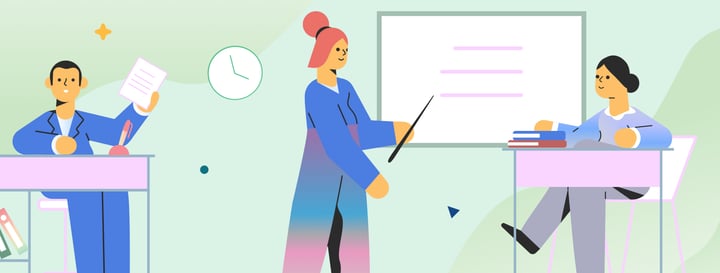To achieve success in any school or district-wide education initiative, it is crucial to have the support and buy-in of teachers. However, teachers already have a multitude of responsibilities, especially amid a pandemic, learning recovery efforts, teacher shortages, and the implementation of new systems and standards. Given these challenges, how can school librarians effectively engage teachers and ensure that reading tracking is not seen as just another task on their already overflowing plate?
With this big question top-of-mind, Beanstack’s senior school success manager Elizabeth Ross hosted a virtual discussion of school media specialists from across the country to talk about nurturing teacher engagement for reading and logging in Beanstack. During the webinar, four panelists from schools with vibrant reading cultures shared their top-line tips for cultivating teacher participation, gave creative examples of how they created on-the-ground buy-in, and answered questions from peers. Here’s a round-up of the six main takeaways from the discussion.
1. Make it a timesaver.
Panelist and Broward County Public Schools media specialist Caryn Cuadra works with a lot of busy teachers at Country Hills Elementary School in southern Florida’s Coral Springs. When introducing Beanstack to teachers, whether for the first time or simply at the beginning of a new school year, she’s found that emphasizing the ease of the platform helps get educators on board.
“I present it more as ‘It’s a solution,’” she said during the discussion. Her school previously used paper reading logs to keep track of daily reading before Beanstack. Digital reading challenges and reading competitions have been a game changer for organization and accountability when it comes to independent reading. “It’s an easy way to keep track of everything. It’s right there, you don’t need to cart papers back and forth to school and home, nothing is getting lost because it’s being put into the computer,” Cuadra said.
She makes sure that promoting reading challenge contests is smooth and simple for teachers, too. Cuadra shares ready-made PowerPoint slides with her teachers to include in their classrooms’ open house slideshows, and she writes reminder messages for them to use throughout the year for a personal connection. “I try to make it something that they could just copy and paste into their newsletter,” Cuadra said. “I find with most of my teachers that they appreciate that. It’s only going to take a minute or two for them to remind their parents again.”
2. Start small and build up.
Nearly every panelist stressed the importance of starting small, scoring early victories, and then scaling up. Cobb County school media specialist Natarsha Miller has put this tactic to work many times in her 5 years working at Belmont Hills Elementary School in Smyrna, GA, just northwest of Atlanta.
When students came back to campus in the fall, Miller decided to focus on creating strong library routines and reading habits. She started each library class period with students signing into their Beanstack accounts and logging their reading—with the help of their teachers.
“My teachers typically stay with their students and help facilitate this and make their students stick to [the routine],” Miller said. The pattern also gets teachers more comfortable and confident in Beanstack. “Now it’s like clockwork. Whether they’re in first grade or fifth grade, this is our routine.” She’s slowly expanding and introducing new Beanstack features, like the reading timer and ISBN scanner, to both students and teachers.
Seasoned educator and panelist Lara Bradshaw also stressed the importance of starting small. After more than 20 years as an educator and four years as the librarian for the pre-K to fifth-grade students at Lily B. Clayton Elementary School in Texas’s Fort Worth Independent School District, she focuses her efforts and then lets success ripple out from there.
“I went to every classroom, so I visited the teacher and the students, in addition to their library visit … and just gave a demonstration on Beanstack, showing the teacher where to go on their laptop, the students had their devices open, and we just all did it together,” Bradshaw said. “I read a book and we all practiced logging minutes together.” Through simple in-person demonstrations, Bradshaw was able to create baseline knowledge and excitement about Beanstack and bring it into the classroom.

3. Offer personal tutorials and help.
Personal tutorials like Bradshaw’s classroom visits help build confidence and a connection with tracking reading in Beanstack. Miller also started the year with personalized tutorials for her school’s teachers.
“I’ve demonstrated for my teachers how to log their minutes for their classrooms themselves. That has been a big help for me,” Miller shared. “I just try to help the teachers as best I can to get their students’ minutes logged. So I will log for them if necessary … but just by showing them a lot of times, they’ll do it themselves.”
Cuadra also strives to use the personal touch. “Teachers have a lot on their plate,” she said. “So I approach it almost like a customer service kind of thing … I am just always there to support them. So at the beginning of the year, often at staff meetings, I’ll remind them about Beanstack, I’ll show them how to use Beanstack, and I send them videos.”
Giving teacher training and student demonstrations a personal touch doesn’t have to be time-intensive. Cuadra, Miller, and Bradshaw all shared video recordings with their teachers and students, especially during the height of the pandemic. Miller even recruited students in the Belmont Hills’ broadcast club to record high-quality and personality-filled Beanstack demonstrations using easy tools like Flipgrid. With demonstrations in English and Spanish, Miller was able to cut down on her instructional efforts and use the videos to promote big school-wide reading contests and unique reading competitions.
4. Recruit "teacher besties" as reading cheerleaders.
Having strong relationships and connections with other educators at your school can be a boon for helping create excitement and buy-in for Beanstack.
“Two of my ‘teacher besties’—one in the primary grades and one in the upper grades—were kind of like my cheerleading team to get Beanstack rolled out,” Bradshaw said of her efforts at Lily B. Clayton Elementary School. One of the teachers even set up a classroom leaderboard contest highlighting which class logged the most minutes per week, and displayed it outside her room. Other teachers would walk by and get curious about how to make one themselves.
“My teacher bestie would say, ‘Oh it’s so easy, let me show you,’” Bradshaw recounted. “It’s helping me promote Beanstack having someone in the primary grades and the upper grades.” Beanstack is valuable for different schools of all age groups, including elementary school, middle school, and high school.
Another panelist, media specialist Chris Parker, also found success recruiting friends at Blue Ridge Elementary School in northern Georgia’s Fannin County. His school had made the switch from Accelerated Reader to Reading Counts and then to Beanstack, so he decided to go slow and start with a few teacher collaborations to test the waters.
“I, like Laura [Bradshaw], have some teacher besties that I have gone to to collaborate with,” Parker said. “We’re dipping our toes in this year, and next year we’ll be going full-in.”
5. Collaborate on changes.
Parker decided to work together with his teacher partners at Blue Ridge Elementary School and use their standards and curriculum to craft custom reading challenges and robust reading competitions for their school students. He used learning activities and reading lists to incorporate specific learning focuses for second and fifth-grade readers. And he used his design skills to create custom banners and badges to tie everything together.
“The second-grade challenge that I created was with the standard that the second graders have with Georgia heroes,” said Parker, showing activity badges depicting Jimmy Carter and Juliette Gordon Lowe. Students would read books on historical figures and then input five facts they learned into the activities.
“My second challenge that I did was with fifth grade, the ‘Wil E. States of Matter,’” he said. For this challenge, Parker honed in on the students’ science curriculum and added five MyON books about the matter to the reading list. Then, he added additional activities and links for students to submit slides and other assignments. “Get that teacher buy-in by using their standards,” Parker suggested to other media specialists. “I just love the moldability of Beanstack and enabling us to do the things I’ve done here with these content area challenges. And our teachers and students are both loving this different side of Beanstack.”
Bradshaw also works to align specific grade-level focuses with Beanstack at Lily B. Clayton Elementary School in Texas. To support a big push for writing development for fourth graders, she worked with the fourth-grade teacher to set up weekly review badges for different types of writing.
“When they were doing nonfiction, she was requiring them to have one book review a week for me to review, telling a factual detail that they liked,” she said. Then, the fourth-grade teacher would call out certain reviews in class to build excitement—often highlighting students who needed a confidence boost or weren’t used to getting academic accolades.
6. Recognize success.
Recognition is a key component to reinforcing any good habit, especially reading. Just about every panelist and many attendees shared tips for making reading success more visible at school.
In Cobb County, Miller shares updates about top readers on their daily school news announcements. “It surprised me,” she shared. “In the reading challenges, I started promoting it on the school news and broadcasting who participated and what class they’re in, and the teachers are excited. They feel like it’s a reflection on them to have their students announced as participating and achieving these reading goals.”
For her Fort Worth elementary school, Bradshaw set up a massive leaderboard in the library to track students’ reading progress throughout the year. “My leaderboard has evolved a lot,” she said. “At first, I started small, like 100 minutes, 500 minutes, 1,000 minutes, and the kids were just reading and reading and reading, so I had to make the numbers larger and more of a challenge to go from one level to another.”
Every Friday, she runs her reports in Beanstack and moves their names across the leaderboard—often in front of the waiting, excited eyes of her students. “They’ll be like, have you done the board yet? They’ll come by and check,” Brashaw shared. “And I’ll have like 20, 30 kids come down just to see where their name is on the leaderboard and they want their friends to know where their names are on the leaderboard.” Some of the teachers add to the excitement by bringing their classes to look at the new leaderboard and take pictures of the advancing students at their new level.
At her Florida elementary school, Cuadra sends around small prizes for teachers to hand out to top readers in their classes at different points in the year. Then, she holds a reading celebration for students at the end of the year. “I give out certificates and medals and it’s based on how many minutes you’ve read,” she said. “It’s a whole big shebang.”
Spread the Love of Reading With Beanstack
With these six tips, we hope you can fortify your outreach strategy and empower your teachers to help you spread the love of reading throughout your school. Listen in to the full conversation for even more ideas and insights. Not yet a Beanstack client? Contact our team today to find out how to get started!


